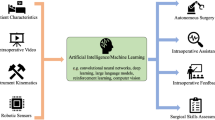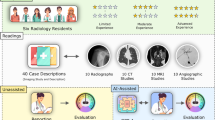Abstract
Purpose
Ultrasound (US) imaging offers advantages over other imaging modalities and has become the most widespread modality for many diagnostic and interventional procedures. However, traditional 2D US requires a long training period, especially to learn how to manipulate the probe. A hybrid interactive system based on mixed reality was designed, implemented and tested for hand–eye coordination training in diagnostic and interventional US.
Methods
A hybrid simulator was developed integrating a physical US phantom and a software application with a 3D virtual scene. In this scene, a 3D model of the probe with its relative scan plane is coherently displayed with a 3D representation of the phantom internal structures. An evaluation study of the diagnostic module was performed by recruiting thirty-six novices and four experts. The performances of the hybrid (HG) versus physical (PG) simulator were compared. After the training session, each novice was required to visualize a particular target structure. The four experts completed a 5-point Likert scale questionnaire.
Results
Seventy-eight percentage of the HG novices successfully visualized the target structure, whereas only 45 % of the PG reached this goal. The mean scores from the questionnaires were 5.00 for usefulness, 4.25 for ease of use, 4.75 for 3D perception, and 3.25 for phantom realism.
Conclusions
The hybrid US training simulator provides ease of use and is effective as a hand–eye coordination teaching tool. Mixed reality can improve US probe manipulation training.




Similar content being viewed by others
References
Sidhu HS, Olubaniyi BO et al (2012) Role of simulation-based education in ultrasound practice training. J Ultrasound Med 31(5):785–791
Bartha L, Lasso A et al (2013) Open-source surface mesh-based ultrasound-guided spinal intervention simulator. Int J CARS 8:1043–1051
Fang TY, Wang PC et al (2014) Evaluation of a haptics-based virtual reality temporal bone simulator for anatomy and surgery training. Comput Methods Programs Biomed 113:674–681
Luboz V, Zhang Y et al (2013) ImaGiNe Seldinger: first simulator for Seldinger technique and angiography training. Comput Methods Programs Biomed 111:419–434
Cook DA, Hatala R et al (2011) Technology-enhanced simulation for health professions education: a systematic review and meta-analysis. JAMA 306(9):978–988
Konge L, Albrecht-Beste E et al (2014) Virtual-reality simulation-based training in ultrasound. Ultraschall Med 35(2):95–97
Johnson SJ, Hunt CM et al (2012) Virtual reality, ultrasound-guided liver biopsy simulator: development and performance discrimination. Br J Radiol 85(1013):555–561
Kneebone R (2003) Simulation in surgical training: educational issues and practical implications. Med Educ 37:267–277
Ni D, Chan W et al (2011) A virtual reality simulator for ultrasound-guided biopsy training. IEEE Comput Graph 31(2):36–48
Blum T, Heining SM et al (2009) Advanced training methods using an augmented reality ultrasound simulator. Proc ISMAR 2009:177–178
Ungi T, Sarent D et al (2012) Perk Tutor: an open-source training platform for ultrasound-guided needle insertions. IEEE Trans Biomed Eng 59(12):3475–3481
Carter FJ, Schijven MP et al (2006) Consensus guidelines for validation of virtual reality surgical simulators. Simul Healthc 1(3):171–179
Burden C, Preshaw J et al (2012) Validation of virtual reality simulation for obstetric ultrasonography: a prospective cross-sectional study. Simul Healthc 7(5):269–273
Chalasani V, Cool DW et al (2011) Development and validation of a virtual reality transrectal ultrasound guided prostatic biopsy simulator. Can Urol Assoc J 5(1):19–26
Milgram P, Kishino AF (1994) Taxonomy of mixed reality visual displays. IEICE Trans Inf Syst E77-D(12):1321–1329
Ferrari V, Cappelli C et al (2008) An anatomy driven approach for generation of 3D models from multi-phase CT images. In: Proceedings of the international congress and exhibition. IJCARS volume 3, Supplement 1/June 2008
Megali G, Ferrari V et al (2008) EndoCAS navigator platform: a common platform for computer and robotic assistance in minimally invasive surgery. Int J Med Robot Comput 4(3):242–251
Freschi C, Troia E et al (2009) Ultrasound guided robotic biopsy using augmented reality and human-robot cooperative control. Conf Proc IEEE Eng Med Biol Soc 2009:5110–5113
Condino S, Carbone M et al (2011) How to build patient-specific synthetic abdominal anatomies: an innovative approach from physical toward hybrid surgical simulators. Int J Med Robot 7(2):202–213
Carbone M, Condino S et al (2012) Anthropomorphic ultrasound elastography phantoms—characterization of silicone materials to build breast elastography phantoms. In: Engineering in medicine and biology society (EMBC), 2012 annual international conference of the IEEE; pp 492–494
Acknowledgments
This work has been financed by “Fondazione Arpa” and by Opera (Advanced OPERAting room) Project (Tuscany Regional Funds: PAR FAS 2007–2013 Azione 1.1 P.I.R. 1.1.B).
Conflict of interest
Cinzia Freschi, Simone Parrini, Nicola Dinelli, Mauro Ferrari, and Vincenzo Ferrari declare that they have no conflict of interest.
Author information
Authors and Affiliations
Corresponding author
Rights and permissions
About this article
Cite this article
Freschi, C., Parrini, S., Dinelli, N. et al. Hybrid simulation using mixed reality for interventional ultrasound imaging training. Int J CARS 10, 1109–1115 (2015). https://doi.org/10.1007/s11548-014-1113-x
Received:
Accepted:
Published:
Issue Date:
DOI: https://doi.org/10.1007/s11548-014-1113-x




